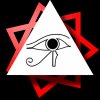Another Review of the Occult Tradition
 Most historians have never heard of the 16th and 17th century Hermetic Philosophers. Neither have most scholars of religion or science - or if they have, they ignore them as an embarrassment. They were the top scientists of their day throughout Western Europe, and they also studied astrology, alchemy, Kabbalah and magic. They were the real-life counterparts of the original fictional Rosicrucians.
Most historians have never heard of the 16th and 17th century Hermetic Philosophers. Neither have most scholars of religion or science - or if they have, they ignore them as an embarrassment. They were the top scientists of their day throughout Western Europe, and they also studied astrology, alchemy, Kabbalah and magic. They were the real-life counterparts of the original fictional Rosicrucians.As historian Frances Yates wrote of the term Rosicrucian, it "represents a phase in the history of European culture which is intermediate between the Renaissance and the so-called scientific revolution".
These were not minor figures. Isaac Newton devoted far more time and energy, and wrote thousands more pages, on alchemy, biblical prophecy and esoteric interpretation of the measurements of the pyramids than he ever did on light and gravity.
In The Occult Tradition, David S Katz starts with the Hermetic Philosophers and the largely ancient sources of their beliefs: Neo-Platonism, Gnosticism, the writings attributed to the mythical Greek/Egyptian philosopher Hermes Trismegistus, and Jewish mysticism. He does a good job in emphasising the importance of both the beliefs and believers. Paracelsus, the 16th-century alchemist, mystic and physician, was not only the first proponent of homoeopathy, but invented the painkiller laudanum and the anaesthetic ether.
In places Katz wanders up some unlikely side-paths. One chapter is devoted to the Freemasons, Swedenborgians and Mormons. Freemasonry, in its beliefs, symbolism and ritual, is very clearly part of the same esoteric tradition as Hermetic Philosophy, but the author's arguments are really straining on the other two.
The 19th century is largely represented by Spiritualism, hypnotism and the birth of psychoanalysis - again, their connections with the Occult tradition are somewhat stretched. Unbelievably, he devotes one paragraph each to the French occultist Eliphas Levi, the Hermetic Order of the Golden Dawn, and "the Great Beast" Aleister Crowley, between them the most crucial influences on present-day esotericism. They took the ideas of the Hermetic Philosophers and developed them in line with 19th century scientific beliefs, and that development continued through the 20th century.
The author has very odd views about precisely where Occultism resurfaced in the 20th century. Because of the emphasis on supernatural events - miracles, healings, the Second Coming - he finds the Occult within American Fundamentalist Evangelical Christianity. (Does he want to be lynched?) Many scholars might agree that the current emphasis on casting out demons in theatre-sized Fu mdamentalist churches is more primitive superstition than Christianity, but that isn't Katz's point. Most of his recent books, including the excellent Messianic Revolution, co-authored with Richard H Popkin, have been on apocalyptic Christianity. It is probably natural that he should draw this into the current book. But it is not what Katz includes that is the problem, so much as what he ignores. In three pages at the end he finally touches on New Age philosophy, and spends two lines on "neopaganism, including ritual magic and the Wicca movement".
In America, Western Europe and especially in Britain, Neo-Paganism and ritual magic are a rapidly growingpart of the religious scene. Figures from the 2001 UK Census reveal that, with a total of some 40,000 adherents, the various Pagan religions of Wicca, Druidry and the Northern Tradition make up the seventh largest religious grouping in Britain, after Sikhism and Buddhism.
Occult or esoteric beliefs always reflect and in some cases influence their times, and Katz is good at showing their changing backgrounds. But in concentrating so hard on the background he consistently misses the foreground.
Today's Neo-Pagans and other esoteric practitioners are the direct descendants of the Hermetic Philosophers to whom Katz devotes the first (and by far the best) third of his book. These people, rather than the tortuous arguments the author indulges in, should be the culmination of his book.


2 Comments:
If my tradition's history is to be believed, we were formed by a group of CoMasons in the mid-1700s in London, England. But who knows. People who know Masonry see a bit of Masonry in some of what we do. But again. It's all up in the air. :shrug:
I was schooled in the Alexandrian Tradition of Witchcraft and there are definite Masonic elements to its practice (as well as some healthy doses of medieval ceremonial magic)... I then moved on to Hermetics which is blatantly Masonic... I now follow a more shamanistic path... only free masonry here is what I've brought in to it. :)
Post a Comment
<< Home